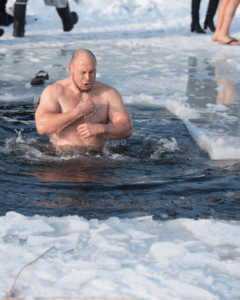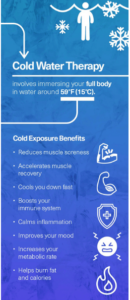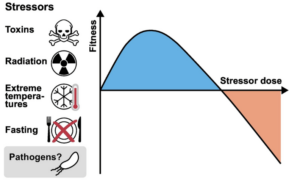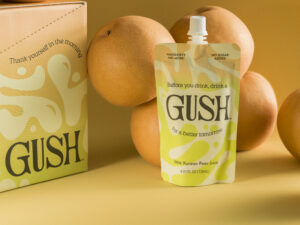Cold plunges have exploded in popularity, especially among guys who pride themselves on mental toughness and resilience. The idea of conquering an ice bath, gritting your teeth through the discomfort – “Just like Rogan does” – and emerging stronger is undeniably alluring. But here’s the thing: just because something is uncomfortable doesn’t mean it’s always good for you 100% of the time. That’s right, it turns out that we can actually push it too far.
 For men, especially those who are really active or reaching for peak performance in their endeavors, cold plunges offer profound and undeniable benefits, from boosting mood and reducing inflammation to developing grit and willpower. However, a lot of people – particularly hard-charging guys – fall into the trap of overdoing it and end up using cold exposure in a way that’s not really optimal.
For men, especially those who are really active or reaching for peak performance in their endeavors, cold plunges offer profound and undeniable benefits, from boosting mood and reducing inflammation to developing grit and willpower. However, a lot of people – particularly hard-charging guys – fall into the trap of overdoing it and end up using cold exposure in a way that’s not really optimal.
If you’re one of those men who thinks “the more pain, the more gain,” it’s time to rethink your strategy on hormesis (adaptive response to intermittent stress). Cold plunges can be a powerful tool for recovery and resilience, but when not used mindfully and strategically, they can actually backfire – slowing or completely inhibiting muscle growth, pushing systemic fatigue, and even messing with your sleep.
The Benefits of Cold Plunges for Men
Mental Toughness & Stress Resilience
Let’s start with the obvious: cold exposure is really uncomfortable. That’s exactly why so many people gravitate toward it; there can be huge utility in exposing our bodies to discomfort. Deliberate cold exposure has been shown to increase dopamine and norepinephrine levels, neurotransmitters that boost mood, focus, and motivation. In fact, research suggests dopamine levels can skyrocket by up to 250% after a cold plunge, creating a lasting state of mental clarity and drive.
bodies to discomfort. Deliberate cold exposure has been shown to increase dopamine and norepinephrine levels, neurotransmitters that boost mood, focus, and motivation. In fact, research suggests dopamine levels can skyrocket by up to 250% after a cold plunge, creating a lasting state of mental clarity and drive.
For men who thrive on challenge, this makes ice baths an excellent tool for building resilience while also getting some unique mental health benefits. Getting into freezing water every morning, or whenever, forces you to push past resistance – cold plunging is uniquely never easy – which tends to translate to better discipline and focus in other areas of life. That’s why so many high-achievers, from entrepreneurs to professional athletes, swear by cold exposure.
Inflammation & Recovery
Cold plunges also have a well-documented effect on reducing inflammation. This is particularly useful after intense training sessions or physical exertion, helping to speed up recovery and reduce soreness. That’s why professional athletes often use cold therapy after games or workouts.
However, this is where the “power through it” mindset can become a problem. While cold plunges help reduce inflammation, they can also interfere with the natural repair process of muscle growth. A lot of guys who are lifting weights regularly have no idea that hopping in an ice bath right after lifting weights can actually cause them to leave gains on the table.
Why You Need to Be Careful
Cold Plunges Can Blunt Muscle Growth
 So, as mentioned, if you’re lifting weights with the goal of building muscle, timing your cold plunges is crucial. Strength training creates microtears in muscle fibers, triggering an inflammatory response that’s necessary for growth and repair. Jumping into an ice bath immediately after a workout can suppress this natural process, limiting muscle protein synthesis and reducing hypertrophy (muscle growth).
So, as mentioned, if you’re lifting weights with the goal of building muscle, timing your cold plunges is crucial. Strength training creates microtears in muscle fibers, triggering an inflammatory response that’s necessary for growth and repair. Jumping into an ice bath immediately after a workout can suppress this natural process, limiting muscle protein synthesis and reducing hypertrophy (muscle growth).
The fix? If building muscle is a priority, avoid cold plunges immediately after strength training. Wait at least 4-6 hours or ideally save them for rest days and/or cardio days.
Cold Plunges Can Add to Systemic Fatigue
Most men reading this blog already push themselves pretty hard in the gym, at work, and in their personal lives. Cold exposure adds another layer of stress to the body. While short-term stress (hormesis) can be beneficial, stacking too many stressors – back-to-back heavy training, cold plunges, lack of sleep, caffeine, etc – can easily lead to burnout, poor recovery, and even immune suppression.
The nervous system plays a critical role here. When you expose yourself to extreme cold, your body shifts into a sympathetic (fight-or-flight) state. If you’re already stressed, overtrained, or sleep-deprived, adding daily cold plunges may be tipping the scale in the wrong direction, leading to persistent fatigue or a weakened immune system instead of the strength we’re aiming for. Our stressors have to be balanced with our ability to recover from them if we want the adaptation.
The fix? If you’re feeling chronically tired or really overwhelmed, cut back on cold exposure and focus on quality sleep and nutrition first; these will always be the foundations of a healthy system. Use cold plunges sparingly during high-stress periods rather than forcing them into an already stacked load – more is not always better.
Cold Plunges Before Workouts? Think Twice
Some men use cold plunges as a pre-workout boost, thinking it will increase alertness and performance. While it’s true that cold exposure raises norepinephrine and sharpens focus, it also causes vasoconstriction – tightening blood vessels and reducing blood flow to muscles. This can negatively impact strength, power output, and flexibility.
The fix? If you want the mental boost from cold exposure before training, try a contrast shower (hot-cold alternation) or a brief splash of cold water on your face rather than full-body immersion.
Cold Plunges Can Disrupt Sleep
Many men plunge into cold water in the evening to “wind down.” While cold exposure can have a calming effect in the right context, it also significantly spikes norepinephrine and cortisol – both of which push us into heightened alertness. If you’ve ever found yourself feeling wired after a nighttime cold plunge, this is why.
The fix? Avoid cold plunges too close to bedtime. If you train in the evening, keep your cold exposure short (1-2 minutes) and follow it with warming techniques like sauna or breathwork to help your body transition into sleep mode.
Best Practices for Using Cold Plunges Wisely
If Muscle Growth is the Goal
- Avoid plunging immediately after lifting weights.
- Wait at least 4-6 hours post-workout or use cold exposure on days where hypertrophy is not the main focus.
For Recovery & Inflammation Control
- Use cold plunges after intense training sessions or competitions.
- Keep sessions brief (3-5 minutes) to avoid over-suppressing necessary inflammation.
- Contrast therapy (alternating hot and cold) can be a good alternative.
To Avoid Nervous System Overload
- Be mindful of overall stress levels – training, work, poor sleep, and cold exposure all add up.
- If feeling chronically fatigued, reduce cold exposure and prioritize the fundamentals of recovery like nutrition and sleep.
- Limit cold plunges to 2-4 times per week instead of daily if stress levels are high.
For Mental Toughness & Mood
- Morning plunges are best for dopamine boosts and mental resilience.
- Even short plunges (1-2 minutes) can be highly effective.
- Pair with breathwork to improve cold adaptation and control stress response. Be sure to have a buddy with you if you’re doing breathwork around or in the cold plunge. It’s definitely possible to black out and drown in a cold plunge, especially if you’re doing breathwork – I suggest doing it after the plunge to get your blood circulation firing back up.
Timing Considerations
- Morning: Great for mental clarity, mood, and resilience.
- Pre-workout: Not ideal for strength training, but may help with alertness if brief.
- Post-workout: Best for recovery but should be avoided right after lifting if muscle growth is the priority.
- Nighttime: Avoid within two hours of sleep to prevent waking yourself up too much.
The Takeaway: Smarter, Not Harder
Men have a natural tendency to push through discomfort, equating pain with progress. While there certainly is value in challenging yourself, there’s a bell curve there lads; cold plunges should be approached strategically – not just as another way to test your limits and push yourself further.
Used wisely, cold exposure can majorly enhance your recovery, resilience, and mental toughness. But ignoring the science and overdoing it can lead to stalled muscle growth, chronic fatigue, and poor sleep. The key is balance guys – we’ve got to recognize that sometimes, less stress is actually better for long-term performance and health.
So, if you’re going to take the plunge, do it smartly. Your body – and your gains – will thank you for it.








